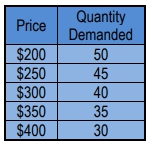Understanding the relationship between elasticity, demand, and revenue is crucial for businesses aiming to optimize their sales strategies. Revenue, defined as the total income generated from sales, can be calculated using the formula:
Total Revenue (TR) = Price (P) × Quantity (Q)
For instance, if a company sells 100 units at \$10 each, the total revenue would be:
TR = 100 × 10 = \$1,000
To analyze how changes in price affect total revenue, the total revenue test is employed. The goal is to maximize revenue by finding the optimal price point that aligns with consumer demand. For example, if the price is set at \$50 and the quantity demanded is 1,000 units, the total revenue would be:
TR = 50 × 1,000 = \$50,000
When the price changes, two primary effects influence total revenue: the price effect and the quantity effect. The price effect refers to the change in revenue resulting from selling units at a different price. For instance, increasing the price to \$60 means earning more per unit sold, but it may also lead to a decrease in the quantity demanded. Conversely, lowering the price could increase the quantity sold but decrease revenue per unit.
To illustrate, if the price is raised to \$60, and the quantity demanded drops to 800 units, the new total revenue would be:
TR = 60 × 800 = \$48,000
In this scenario, total revenue decreased despite the price increase, indicating that the quantity effect outweighed the price effect. This leads to a critical understanding of elasticity:
- If total revenue increases when price increases, demand is inelastic.
- If total revenue decreases when price increases, demand is elastic.
- If total revenue remains unchanged when price changes, demand is unit elastic.
In the example provided, since total revenue decreased when the price increased, it confirms that demand is elastic. This means that the decrease in quantity demanded was significant enough to offset the higher price, highlighting the importance of understanding consumer behavior in pricing strategies.


